Dinosaur Impressions --
|
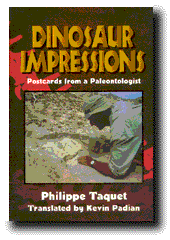 |
|
Dinosaur Impressions --
|
 |
|
The worldwide web, the cell phone, the satellite dish, the jumbo jet, the ubiquitous eye of the television camera, have all served to shrink the world to the size of a big blue marble; or so it may seem to the couch potato. Paleontologists know better. Unlike our colleagues in so many other occupations, it is our privilege and joy to travel to destinations delightful and obscure, to savor the vista unseen by the masses or even by the elite, to know the ways of humble folk and true, to know hardship, the rigors of extreme climates, to go to bed unwashed, to rise unshaven, to savor the delicate hues of sunrise and the blaze of night skies in the desert, to lead a sometimes monastic celibate life in a spartan cell of canvas-all of this in return for the ecstatic bliss of fossil discovery.
Philippe Taquet, France’s premier paleontologist has experienced all of this and more. Best of all, Taquet is a raconteur par excellence. He writes of his adventures with wit, and grace. I have been privileged to hear his story-telling many times. He is fluent in charming English, but his words come to us on this occasion through the smooth intermediary of Kevin Padian’s nearly invisible hand. Taquet tells us of finding his way across the trackless sands of the Ténéré Desert of Niger by following camel droppings; of flying on Aeroflot from Moscow to Irkutsk while vodka flowed like water-even in the cockpit!; of sitting on top of the glowing engine block of a lumbering Soviet truck in 100 degree weather of the Gobi Desert of Mongolia; of sacrificing a pig to appease the local gods so that he could be permitted to collect bones of the "sacred buffalo" in Laos; and of futilely trying to eat enough of the local chickens in a Laotian village to get a night’s sleep!
 Taquet
rode the tall-spined back of the Saharan iguanodont, Ouranosaurus
nigeriensis (Figure 1),
all the way to the pinnacle of success, in his case to the directorship
of Museum National d'Histoire Naturelle in Paris. He is also a member of the
French Academy of Science. Dinosaur Impressions is the story of
Taquet’s life as a paleontologist, beginning with his graduate research
project. The narrative commences in December, 1964, in the office of the
distinguished professor Jean-Pierre Lehman. A 24 year-old Taquet, in accepting
Lehman’s invitation, unwittingly answered in the affirmative the question,
"Do you take paleontology as your spouse and promise to serve her
faithfully for the rest of your days?" With that, Lehman smiled impishly,
pulled a ticket out of his desk drawer, and informed the young man that his
plane for Niger left in seven days, and not to forget to take his quinine!
Making the rough ride out into the desert, he was taken by French Atomic Energy
Commission scientists to a spot, the now-famous locality of Gadoufaoua (meaning
"the place where the dromedaries are afraid to descend among the bumpy
rocks" in the Tamachek language of the Tuaregs), that greatly rewarded the
effort expended:
Taquet
rode the tall-spined back of the Saharan iguanodont, Ouranosaurus
nigeriensis (Figure 1),
all the way to the pinnacle of success, in his case to the directorship
of Museum National d'Histoire Naturelle in Paris. He is also a member of the
French Academy of Science. Dinosaur Impressions is the story of
Taquet’s life as a paleontologist, beginning with his graduate research
project. The narrative commences in December, 1964, in the office of the
distinguished professor Jean-Pierre Lehman. A 24 year-old Taquet, in accepting
Lehman’s invitation, unwittingly answered in the affirmative the question,
"Do you take paleontology as your spouse and promise to serve her
faithfully for the rest of your days?" With that, Lehman smiled impishly,
pulled a ticket out of his desk drawer, and informed the young man that his
plane for Niger left in seven days, and not to forget to take his quinine!
Making the rough ride out into the desert, he was taken by French Atomic Energy
Commission scientists to a spot, the now-famous locality of Gadoufaoua (meaning
"the place where the dromedaries are afraid to descend among the bumpy
rocks" in the Tamachek language of the Tuaregs), that greatly rewarded the
effort expended:
Suddenly, around a small sandstone promontory, appeared one, then two vertebral columns. But this time, they were not the bleached bones of dromedaries. The vertebrae were of a somber color, bluish and stony. Some of them were still encased in the sandstones that had protected them from destruction for millions of years. The spectacle was striking. Imagine…no. It’s unimaginable, because there is no equivalent in nature. Over many hundreds of square meters, huge skeletons were embedded in the sand, lounging or lying on their flanks like dromedaries at night. The undulations of sand reminded me of a beach where a herd of elephant seals were stretched. But these were not dromedaries, nor elephant seals: They were dinosaurs. (p. 8).
What a way to begin a scientific career! He
plunged into the work, modestly discounting the role of luck. "So the bone
hunter has to be a successful geologist, rambler, and naturalist. And then he
has to transform himself into a roadworker, a sculptor, a plasterer, and a
trucker." (p. 13). The account not only documents the romantic part of
paleontology, the travel to exotic places, the thrill of discovery, the drudge
of digging, but also the scientific analysis, following the study of Ouranosaurus
to its completion. The Arab word ourane means "brave, courageous
bold," and is applied by the Tuareg to the sand monitor. Linnean
classification is developed (with a nod also to cladistics, the modern method of
phylogenetic analysis), Cuvier’s anatomy is explored, and the historical
development of the concept of the Dinosauria in England is traced, with due
acknowledgment of Cuvier’s contribution to that subject. 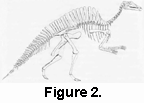 With
these sure principles in place, the author guides us to the correct assessment
of Ouranosaurus as an iguanodont, the African representative of
the clade that includes the first herbivorous dinosaur known to science, and to
the animals whose massed remains were discovered more than 300 meters
underground in a coalmine in Bernissart, Belgium in 1878. The shape of the skull
of Ouranosaurus prefigures that of hadrosaurs, with its arched
nose and broad beak, but without the dental battery of the latter (Figure
2). Taquet published the definitive monograph on Ouranosaurus
in 1976, thus establishing himself as one of the premier dinosaur
paleontologists in Europe, his career forever linked with the National Museum.
With
these sure principles in place, the author guides us to the correct assessment
of Ouranosaurus as an iguanodont, the African representative of
the clade that includes the first herbivorous dinosaur known to science, and to
the animals whose massed remains were discovered more than 300 meters
underground in a coalmine in Bernissart, Belgium in 1878. The shape of the skull
of Ouranosaurus prefigures that of hadrosaurs, with its arched
nose and broad beak, but without the dental battery of the latter (Figure
2). Taquet published the definitive monograph on Ouranosaurus
in 1976, thus establishing himself as one of the premier dinosaur
paleontologists in Europe, his career forever linked with the National Museum. 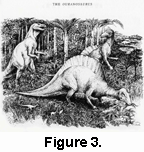 In
1973 came a major turning point when Italian industrialist Giancarlo Ligabue
from Venice, excited by Taquet’s work, decided to finance expeditions to such
destinations as Brazil, Argentina, Mongolia and elsewhere, in fact to wherever
Taquet decided to go--a godfather indeed! Such farsighted philanthropists, as
well as dedicated amateurs, provide invaluable support to the efforts of
paleontological professionals.
In
1973 came a major turning point when Italian industrialist Giancarlo Ligabue
from Venice, excited by Taquet’s work, decided to finance expeditions to such
destinations as Brazil, Argentina, Mongolia and elsewhere, in fact to wherever
Taquet decided to go--a godfather indeed! Such farsighted philanthropists, as
well as dedicated amateurs, provide invaluable support to the efforts of
paleontological professionals.
Some of Taquet’s accounts not only make interesting reading but provide tantalizing details of truly significant finds that have not yet enjoyed scientific description. For example, Taquet documents the recovery of a very early cetiosaur (i.e., primitive sauropod) skeleton from Toarcian (late Early Jurassic) deposits from Wawmda of the High Atlas Mountains in Morocco. Cetiosaurs, Richard Owen’s "whale lizard," which the distinguished British scientist thought to be a giant marine crocodile when he described it in 1841, are poorly known from Middle Jurassic (Bathonian) deposits of England. The Moroccan specimen is large, with a femur length of 2 meters and a rib of 2.2 meters, and includes a skull a meter long! Sadly, though collected in 1980 and 1981, the specimen has not been described nor the skull illustrated.
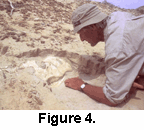 Taquet
was mightily impressed with the vast grassy steppes of Mongolia, which he
visited in 1991. Especially striking was the legendary hospitality of the
nomads:
Taquet
was mightily impressed with the vast grassy steppes of Mongolia, which he
visited in 1991. Especially striking was the legendary hospitality of the
nomads:
The traveler passing by camp is invited to stop and enter the ger, a tent made of walls of camel skins covered on the outside by flapping white silks. Inside the ger he’ll be offered harack, fermented mare’s milk--delicious, sour, refreshing, and diuretic to boot--with a few flies floating on top for extra protein. Little cheeses, and eventually enough Mongolian vodka to knock someone over, complete the hosts' duties to his guest. (p. 131)
Fossils from the classic localities were easy to come by, including mammal skulls. The author particularly thrilled at finding a superb skull of the famous Protoceratops at Tugrig.
One of the most striking venues for fossil collecting is Laos--striking in the sense that when one thinks of great fossil locales of the world, one thinks of great desert areas, not tropical jungles. But the tropics, particularly those associated with French colonies of by-gone years, have been generous in recently--witness the discoveries of Cretaceous theropods and sauropods in Madagascar by David Krause and colleagues. Taquet relates the history of an otherwise obscure French geologist, Josué-Heilmann Hoffet, who worked in Laos from 1927 until his death at the hands of the Japanese in 1945. Hoffet discovered and described ornithischians and sauropods from Cretaceous deposits in that country, but his publications languished in nearly-forgotten obscurity until 1990 when Taquet decided to re-visit the localities. Before being allowed to collect bones, he was required to pay unusual homage to the local gods:
Clearly, there was no way around it; so many years after Hoffet first passed through, we were going to have to make a sacrifice. The local priest, a small man with quick eyes, was called, and I bought a pig for the price of ten thousand kips (about 100 francs, £10 or $17)-a sum I dutifully recorded in the budget for reimbursement to me, as responsible agent for the Museum. The sacrifice settled, villagers and visitors alike assembled for an excellent lunch of-yes, sacrificial pork, prepared according to traditional recipes: grilled, boiled, chopped and mixed with herbs and spices, marinated in fiery sauces. All of it was washed down with great glassfuls of soum-soum, the locally made rice brew. During the meal, one had to take care not to forget the ancestors who had gone on before; they were honored by spilling a few drops of alcohol on the ground through the floorboards. And all this had the salutary effect that the whole troop was authorized to take to the forest road under the scorching sun of lower Laos, to follow Hoffet’s trail. (p. 156)
The sacrifices one has to make for paleontology! The sacrifice was evidently received by the gods, because Taquet once again found significant fossils of iguanodonts and sauropods. The outcome of this project was to establish a museum for the fossils in situ in Laos, as well as a college in the name of Hoffet in Vientiane.
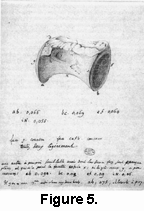 Once
thing that I particularly appreciate about the book is that it comes out of an
independent tradition that reflects decidedly European views that are so easily
drowned out by the demographic crush of English-speaking paleontologists. We
find, for example, less than complete enthusiasm for the theory of catastrophic
extinction of dinosaurs. Few indeed are the dissenters on this side of the
Atlantic-I can only applaud! Taquet is well known to American dinosaur workers
but is, to our detriment, far from a household name.
Once
thing that I particularly appreciate about the book is that it comes out of an
independent tradition that reflects decidedly European views that are so easily
drowned out by the demographic crush of English-speaking paleontologists. We
find, for example, less than complete enthusiasm for the theory of catastrophic
extinction of dinosaurs. Few indeed are the dissenters on this side of the
Atlantic-I can only applaud! Taquet is well known to American dinosaur workers
but is, to our detriment, far from a household name.  It
is fresh and valuable to learn his take on the history of dinosaurs, especially
of those discovered in the 19th century, to learn the importance of the early
fossils from Normandy, including Cuvier’s "gavial" from Honfleur of
1800 (published in 1808), which we now recognize as one of the first scientific
descriptions of dinosaur remains (Figure
5). Taquet has already published the documents of Cuvier’s correspondence
with Buckland and Mantell that led to the first named dinosaurs, Megalosaurus
and Iguanodon in England in 1824 and 1825, respectively. We
also learn about the all-but-forgotten theropod Poikilopleuron
bucklandii described by Eudes-Deslongchamps in 1837 (Figure
6).
It
is fresh and valuable to learn his take on the history of dinosaurs, especially
of those discovered in the 19th century, to learn the importance of the early
fossils from Normandy, including Cuvier’s "gavial" from Honfleur of
1800 (published in 1808), which we now recognize as one of the first scientific
descriptions of dinosaur remains (Figure
5). Taquet has already published the documents of Cuvier’s correspondence
with Buckland and Mantell that led to the first named dinosaurs, Megalosaurus
and Iguanodon in England in 1824 and 1825, respectively. We
also learn about the all-but-forgotten theropod Poikilopleuron
bucklandii described by Eudes-Deslongchamps in 1837 (Figure
6).
For those who don’t know, there is renewed interest in dinosaurs from France at present. For the most part, these come not from Normandy but from the south of France, the region made famous by abundant dinosaur eggs, especially those presumed to have been laid by the sauropod Hypselosaurus. The story continues. All in all the book is a delightful read. Taquet and his translator Padian are greatly to be congratulated. Enjoy!
Copyright:
Coquina Press
22 October 1999
http://www-odp.tamu.edu/paleo/index.htm